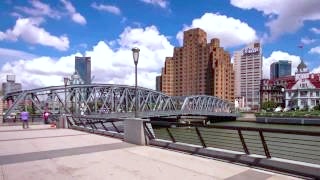With MiaoMiao ...
[640],shadow=true,start=,stop=Zhangjiang Science City, located in the Pudong district of Shanghai, is a major hub for scientific innovation and research in China. Often referred to as the "Silicon Valley of China," Zhangjiang Science City has been a focal point for the development of high-tech industries, particularly in the fields of biotechnology, information technology, and advanced manufacturing.
Key Features and Developments:
Research and Development Hub:
Zhangjiang Science City hosts numerous research institutions, universities, and corporate R&D centers. It's home to the Zhangjiang National Innovation Demonstration Zone, which plays a critical role in fostering technological innovation.
The area is known for its strong focus on life sciences, with many pharmaceutical companies and biotech firms operating there, including multinational corporations like Roche and Novartis.
Tech Startups and Incubators:
The region has a thriving startup ecosystem, supported by various incubators and accelerators. This makes it an attractive destination for tech entrepreneurs and innovators.
The Shanghai Zhangjiang Hi-Tech Park, within the science city, is one of China's most prominent technology parks, providing resources and infrastructure for startups.
International Collaboration:
Zhangjiang Science City emphasizes international collaboration, with numerous foreign enterprises establishing their R&D centers there. The area facilitates joint ventures and partnerships between Chinese and global companies.
The establishment of free trade zones and favorable policies has further encouraged international investment and collaboration.
Smart City Development:
As part of the broader Shanghai initiative, Zhangjiang is being developed into a "smart city" with advanced infrastructure for communications, transport, and urban living.
The integration of AI, big data, and IoT technologies into the city’s infrastructure is a key aspect of its development, making it a model for future urban areas.
Education and Talent:
The science city benefits from proximity to top-tier universities and research institutions, which supply a steady stream of talent in various scientific and engineering disciplines.
Efforts are made to attract and retain international talent, offering competitive incentives and a conducive environment for innovation.
Government Support:
The Chinese government has prioritized Zhangjiang as a key area for the country’s strategic technology development. Policies are in place to support research, attract investment, and encourage innovation.
Significant investments have been made in infrastructure, including transport links that connect Zhangjiang to other parts of Shanghai and beyond, enhancing its accessibility and appeal as a business location.
Future Prospects:
Zhangjiang Science City is poised to continue its growth as a global leader in science and technology. With ongoing investments and a focus on high-tech industries, it is expected to play a significant role in China's ambitions to become a world leader in innovation and technology by the mid-21st century. The combination of government support, international collaboration, and a strong innovation ecosystem makes Zhangjiang Science City a critical component of Shanghai's, and indeed China's, future development strategy.
Shanghai is one of China's most dynamic and cosmopolitan cities, blending a rich history with modern skyscrapers and vibrant culture. Here's what you need to know as a tourist visiting Shanghai:
Historical and Cultural Landmarks:
The Bund: This iconic waterfront promenade along the Huangpu River features colonial-era buildings on one side and futuristic skyscrapers on the other, offering stunning views of Shanghai's skyline.
Yu Garden: Dating back to the Ming dynasty, Yu Garden is a classical Chinese garden with pavilions, ponds, and rockeries. The nearby Yu Garden Bazaar is a great place to shop for souvenirs and traditional crafts.
Shanghai Museum: Home to an extensive collection of Chinese art and artifacts, including bronzes, ceramics, paintings, and calligraphy, the Shanghai Museum is a must-visit for history and art enthusiasts.
Jing'an Temple: One of Shanghai's most famous Buddhist temples, Jing'an Temple is known for its beautiful architecture, peaceful atmosphere, and towering golden Buddha statue.
Modern Attractions:
Shanghai Tower: Ascend to the observation deck of this iconic skyscraper, the tallest in China and the second-tallest in the world, for panoramic views of the city.
The Oriental Pearl TV Tower: Another iconic landmark, this futuristic tower offers observation decks, a glass-bottomed skywalk, and a revolving restaurant.
Shanghai Disneyland: Located in the Pudong district, Shanghai Disneyland offers a magical experience for visitors of all ages with its themed lands, attractions, and entertainment.
Shopping and Entertainment:
Nanjing Road: One of the world's busiest shopping streets, Nanjing Road is lined with department stores, boutiques, and restaurants. Don't miss the nearby pedestrian-friendly Nanjing Road East, known for its lively atmosphere and street performers.
Xintiandi: This upscale shopping, dining, and entertainment district features a mix of traditional Shikumen-style buildings and modern amenities, making it a popular destination for locals and tourists alike.
French Concession: Explore this historic neighborhood known for its tree-lined streets, charming cafes, boutiques, and art galleries.
Culinary Delights:
Shanghai Cuisine: Sample local specialties such as xiaolongbao (soup dumplings), shengjianbao (pan-fried dumplings), and Shanghai-style noodles.
Street Food: Wander through the city's bustling food markets and snack streets to taste a variety of street foods, from savory pancakes to grilled skewers.
Practical Tips:
Transportation: Shanghai has an efficient public transportation system, including the subway, buses, and taxis. Consider purchasing a rechargeable transportation card for convenience.
Language: While Mandarin is the official language, English is widely spoken in tourist areas, hotels, and restaurants.
Weather: Shanghai experiences four distinct seasons, with hot, humid summers and chilly winters. The best times to visit are spring (March to May) and autumn (September to November) when the weather is mild and comfortable.
Etiquette: Respect local customs and traditions, such as using polite language and avoiding loud behavior in public places.
Shanghai offers a captivating blend of old and new, with its historic landmarks, modern skyscrapers, vibrant culture, and delectable cuisine. Whether you're interested in history, architecture, shopping, or dining, Shanghai has something to offer every type of visitor.
 ZhangJiang Science City, PuDong, ShangHai
ZhangJiang Science City, PuDong, ShangHai















